One of the few things I’ve done longer than sailing is photography. Combining the two can bring the best of both worlds, capturing the magic of sailing in an aesthetically pleasing medium. It can be endlessly fascinating to record the way a shapely hull slices through the water or the infinite ways the sun highlights the curve of a sail.
In the age of film cameras, shooting pictures of other crafts while afloat required a heavy telephoto lens, usually 200 mm or longer for a 35 mm camera. Shooting a lot of pictures could quickly add up in terms of film and processing costs, so the tendency was to take one or two pictures and hope for a good one.
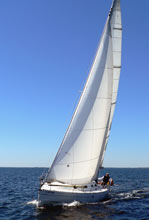 |
The Panasonic Limix 5 megapixel camera that shot this has a high quality opitcal zoom and image stabilization, making it easier to get a shot like this – which reminds us of why we sail. The downside to the camera? Not an iota of water resistance, so it must be coddled while onboard. I restrict it to larger boats and moderate conditions.
Click images to enlarge |
From that perspective, the age of digital photography is a boon. Good quality cameras, with the equivalent of 300 mm or longer optical zoom lenses are available for moderate prices, in some cases less than $200. Large capacity memory chips mean a large number of pictures can be taken in favorable conditions, and the bad ones simply erased while the digital “film” is reused an infinite number of times. An additional bonus is modern digital cameras can do something the still film cameras never could: They can shoot video clips! Yet another way to catch the sailing experience.
Of course there is a drawback. Digital equals electronic. Water is bad for electronic gizmos. Doubly so if, like me, most of your sailing is done on salt water. My old 35 mm cameras had electronic meters to help set the exposure (I never had automatic film cameras), but the shutter and lens aperture were mechanical. A few stray drops of water were not going to turn the cameras into expensive paperweights, which can happen with a digital camera.
So here’s a few ramblings about shooting digital pictures in a hostile, moist environment (please look elsewhere for artistic instruction). This is a Duckworks perspective. That is, you can usually solve a problem by throwing lots of money at it, but we’re looking at low-cost solutions. (The obvious expensive solution is to buy a good digital camera and then spring for a waterproof plastic case, if one is offered for it. But the case alone can cost as much as the camera, an amount that would pay for the plywood, epoxy and fiberglass to build a small hull.)
The first option is to take the good quality digital camera you probably already have and use it. The upside is that camera is probably pretty sophisticated, with a good optical zoom and other desirable features. The downside is the use will be limited. I have a 5 megapixel Panasonic Lumix series digital camera that takes wonderful pictures. But I will only use it in good weather on our 30-foot boat. Even then I take care when not using the camera to make sure it is in a camera bag and secured in a dry part of the boat. Until the spray flies (when the wind gets to around 15), it’s a great camera to use. It has a 12:1 optical zoom (equivalent to a 600 mm lens on a 35 mm) and a razor sharp Leica lens. It also features image stabilization, which takes some or all of the blurriness out of a picture when shooting in a low-light setting. Probably not a big deal when shooting other boats on a bright, sunshiny day, but then when snapping the shutter from a rocking deck, every little bit helps. The only technical problem I’ve had shooting with this camera is the auto focusing mechanism seems to have trouble when taking a picture with the sun directly behind.
| The Panasonic Lumix. With a 5 megapixel picture size, it will produce a razor sharp 8 x 10, even with some image cropping. The eyepiece makes shooting outside on a bright day easy. Unlike the other cameras mentioned in this article, it can also be fitted with a polarizing filter, which can improve outdoor shots. |
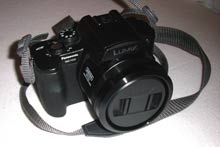 |
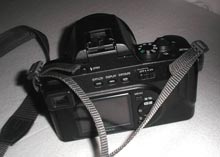 |
I don’t dare take this camera on our 11- or 20-foot unballasted boats. Even on a calm day, water will be tracked into these boats and hands will get wet, if not salty and wet, from handling lines that drop into the water or from spray. Not to mention if there’s a bad gust, accidental gybe or other freakish mishap, there’s no guaranteed dry place to keep the camera, short of a waterproof box. Which, of course, is where the camera is likely to be when the perfect shot comes along – and goes.
Another option is to go as inexpensive as possible. In the 2006 Everglades Challenge, Chuck from Duckworks brought along a “splashproof” Pentax Optio camera, one of the square-shaped models. It took great pictures (we shot a cover for Small Craft Advisor with it) and it took a liberal amount of splashing without trouble. I thought about taking the Panasonic in the 2007 EC in some sort of waterproof bag or box, but decided not to risk it – a good decision as the boat got thoroughly wet inside and out. For 2008, I began casting about for an inexpensive alternative. I checked eBay, hoping to find a good used camera, maybe an Optio like Chuck’s. But Optios seem to be in demand with used ones commanding a good price, more than I wanted to pay. So I began looking at other waterproof or water resistant alternatives.
Here’s what I wanted: at least a 4-megapixel camera, with the ability to shoot video clips and a modest optical zoom lens, maybe 3:1. In most cases, shots would be taken on the boat used in the race (a 20-footer), not of other craft so the modest zoom was acceptable. As for the video capacity, I was hoping to get a 480 by 640 pixel size that would shoot at 30 frames per second; a lesser frame rate can seem jumpy especially if it’s only around 15 fps. (640 by 480 video will look pretty good full size on a 14 or 15 inch computer screen; 320 by 240 video starts to fall apart on sharpness if blown up to full screen.) And I wanted it all for under $100.
That proved to be a pipe dream, and here’s what I settled for: A 5 megapixel camera from VuPoint Solutions that comes with a waterproof case rated to about 50 feet underwater. It does not have an optical zoom although it “boasts” an 8:1 digital zoom (more about that in a minute). It does shoot video clips at 480 by 640 pixels, but only at 20 fps. If the image size is dropped to 320 by 240 pixels, then the camera will shoot at 30 fps. It cost about 80 bucks, with shipping through Amazon.com. (I have seen this camera, with different brand names, including Vivitar, sold in other venues, including eBay, at prices ranging from $80 to $130 or so. Even Walgreens had it at their camera counter recently for $99.)
 |
The VuPoint Solutions camera, in and out of its waterproof case. It can’t match the optical quality of the Panasonic and the digital zoom is poor, but in its case it’s durable and rugged for boating use. It doesn’t have an optical viewfinder and it can be a bit hard to see much on the LCD screen on a sunny day, but I usually manage to hit what I’m aiming at. Since many of my pictures aren’t printed and are only displayed on computer, the loss of image quality is less noticeable. Here’s a buying strategy: Since it’s fewer features make it easy to use, get one for your kids, and then hijack it in the waterproof case when you go out on a boat . . . . |
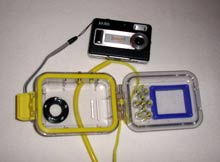 |
 |
What’s good about this camera is the case seems rugged and the camera floats when it’s in the case – a good thing as it once spent several minutes bobbing in the water after we flipped the 20-footer. I’ve also stuck it underwater and snapped some pictures, just to verify it works as advertised. The 20 fps video can be a bit jumpy, but the video clips are above adequate. If you’re narrating a video while shooting when the camera is in the case, you’ll have to shout a bit to be recorded.
The main downside is still picture quality. That’s a combination, I suspect, of less expensive optics and a high digital compression ratio. The Panasonic can shoot uncompressed images as well as several levels in the compressed JPEG format. The VuPoint, nominally rated at the same 5 megapixels, shoots only at three levels of JPEG and at its highest quality, the resulting digital files are much smaller than the files from the Panasonic shooting at its top JPEG level. You can also see it in the pictures; that razor sharpness of the Panasonic isn’t there. It does seem, though, that the brighter the light, the better the picture from the VuPoint, although on occasion, pictures taken in the bright sunlight are fuzzy. The digital zoom also is a disappointment. Even at 2:1, and the picture sharpness falls apart. I had hoped to use the zoom when shooting video clips, but that isn’t possible.
| Cassiopeia jellyfish shot at Long Key State Park in the Florida Keys, holding the VuPoint Solutions camera underwater. |
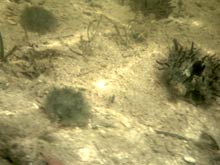 |
Overall, the quality is like the difference between a high-grade 35 mm camera and the disposable 35 mm you buy at the drug store for a vacation. About what you’d expect for an $80 camera that comes with a waterproof case. Because it uses two AAA batteries instead of AA batteries like some other digital cameras, battery life is so-so.
Despite the drawbacks, I’m more than satisfied with the VuPoint. Although it’s quality cannot touch the Panasonic, it will go places the Panasonic will never see because of its all-weather durability. It’s easy to store it in a bulkhead bag or even set it down on the bottom of a small sailboat or kayak without being terminally concerned about its survival.
 |
The VuPoint will usually deliver its best pictures shooting outside. But sometimes, inexplicably, one will come out blurry, even when shot at a high shutter speed, like this image, shot at 1/500th second. |
A middle road between the Panasonic and the VuPoint would be one of the now available waterproof (without a case) consumer digital cameras like Chuck’s. The Pentax Optio and Olympus Stylus waterproof cameras are perhaps the best known examples. (While the newer models are waterproof and can shoot underwater, they don’t have near the 50-foot depth rating of the VuPoint in its case.) Through a happy set of circumstances, I got a chance to try that route.
Last year I had a minor but very painful surgery that had me laid up at home for a couple weeks. Maybe it was the heavy-duty painkillers, but I had a fixation on stalking eBay checking out the auctions of waterproof and water resistant digital cameras. I was hoping to snag a Pentax Optio W10 (there are also the newer W20 and W30 models), which shoots 6 megapixel stills and the 640 by 480 pixel movies at a full 30 fps, but those kept going, even factory reconditioned models, for well above what I wanted to pay. But while searching the water resistant category, I found the older Pentax Optio box models, like Chuck’s. Of particular interest was the Optio WR 43, apparently the last model of the box style (the shape is surprisingly easy to use). It shoots 4 megapixel images with a 2.8:1 optical zoom and additional 4x digital zoom, and shoots 30 fps videos at 640 by 480, 320 by 240 and 160 by 120 pixels. The Pentax also has an optical viewfinder as well as LCD screen, which makes it easier to shoot outside on a bright day. The catch was it seemed to command the same price, even used, as the Optio W10s.
Then in one of those incredible deals that you brag about for the rest of your life, I managed to win a bid on one for less than half of what others had been going for, indeed significantly less than what I paid for the VuPoint. It was even in like- new condition. Advertised as water resistant, the camera instructions say it can withstand about 15 minutes immersed to a depth of around a foot, although you can’t shoot while it’s under water. It feels much more rugged and substantial that the uncased VuPoint, and undoubtably is. That, however, has the drawback that it will sink if dropped overboard.
| The Pentax Optio WR43. A nice camera with good optics, a modest optical zoom, and good video clip quality. The optical viewfinder is nice on a bright day. It won’t float like the VuPoint or shoot underwater, but otherwise beats it in every other category, except price. A nice middle ground between going as cheap as possible and the most expensive solution of buying an expensive, feature-filled camera and an equally expensive waterproof case. |
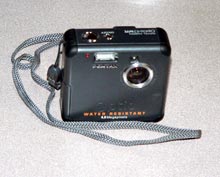 |
 |
Technically, it has many more features than the VuPoint, and in terms of quality, it shoots rings about it even though its megapixel rating is smaller. That shows up in file sizes; the Pentax does much less compression of its JPEG images, which in turn means larger file sizes and better image quality. In fact, you have to look pretty closely to detect a difference between the Pentax and Panasonic shots. The Pentax, though, does not have the image stabilization of the Panasonic, and so suffers a bit in low-light level shooting.
The lower level of compression also extends to the video, which with the Pentax is noticeably better and smoother, thanks to the 30 fps instead of 20 fps. All of that makes the Pentax the camera of choice for shooting from small boats.
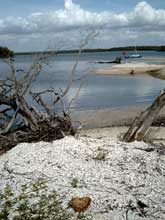 |
 |
| Two of my favorite pictures from this years Everglades Challenge were taken with the VuPoint Solutions camera in its waterproof case, mostly because it was the camera at hand when the shot came up. Especially the shot at Lostman’s River. I grabbed the VuPoint because I didn’t expect any great images, but you never know what you’ll find. |
But interestingly, the VuPoint has not been retired, sold, or given away, and still finds a fair amount of use. I think of it as the postcard camera; useful when not looking for an artistic masterpiece but rather for a “postcard” memory shot. It’s also the choice in really nasty conditions and situations where damage to the camera is a possibility. The case provides protection in those situations and it’s always better to have at least a postcard of a great shot than no shot at all. The high compression/smaller file size of the VuPoint also has an interesting benefit – you can record a huge amount of images or video on one memory card. With a 2 gig SD card (the largest this camera can handle), it will shoot over 2 ½ hours of video at 640 by 480 and 20 fps (the batteries will die before the card is full). The Pentax, by comparison, at 640 by 480 pixels and 30 fps will shoot about 33 minutes on the same chip. There’s a similar ratio for the number of still images that can be fit on the card. In a hostile environment where you’d be reluctant to open the battery or memory card compartment (or the waterproof case), that could be an advantage for the VuPoint. And of course, you can swim and snorkel with the VuPoint, and shoot underwater, neither of which is recommended for the Pentax. The flip side of having the fewest features is that the VuPoint is also the easier to use, most notably when switching between still and movie modes. That only takes the push of a button.
There is a fourth option I haven’t tried, at least with digital cameras. A couple companies make waterproof plastic pouches or bags that are advertised as waterproof and are sized to fit a number of different digital cameras. I might have gone that way with the Panasonic, but no one made a bag that fit my particular model. I have used a waterproof bag for my handheld marine radio and have noticed that if it’s left out in the sun too long, condensation forms inside the bag and I’ve heard that the underwater camera bags can have the same problem. That’s something that can usually be dealt with, but should be kept in mind.
 |
Pictures help remember the special times on a boat. |
For me, the Pentax and the VuPoint have made taking pictures while sailing easier and safer for the equipment. Consequently, they have increased the opportunity for nautical photography, and the enjoyment of combining both pasttimes.
*****
|

